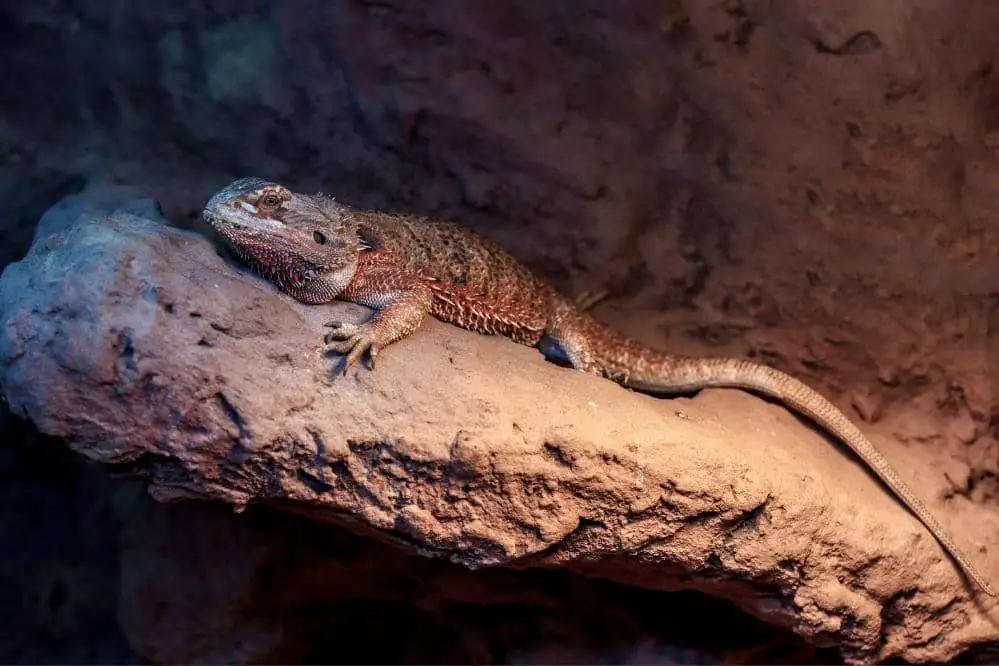If you have recently adopted a bearded dragon, you may be upset to find that your new bearded friend spends most of his time lying under (or near) the basking lamp. You have landed on this page because you have already started your research. You may already have found from different online sources that bearded dragons spend a lot of time lying on the sand or rocks when the sun is shining, in the wild conditions too. But the real mystery, “why do bearded dragons actually bask” “how long should a bearded dragon bask” or when we are rearing them in captivity, “what temperature do they actually need to bask,” still need to be disclosed. So we have created a comprehensive post to disclose the mystery for bearded dragon fanciers, especially the first-time owners. Let’s proceed…….
Why Do Bearded Dragons Actually Bask?
All the animals need heat to break down food, extract nutrients from it, and absorption into body tissue. If sufficient heat is not available, it means no food digestion and no nutrients available to the body, and obviously, in that case, survival will be impossible. Generally, there are two types of living organisms; first, they can produce their own body heat, called endothermic animals (like humans and other mammals). The second group of animals is those who can’t produce their own body heat and depend on external heat sources to get the necessary heat, which are called exothermic animals (like amphibians and reptiles).
Since our bearded friends belong to the reptile community, so they are exothermic too. So they need to absorb heat from some external heat source for proper digestion, absorb nutrients, bone development, and overall growth. Therefore bearded dragons spend most of their day time lying in the bright sunlight (in the wild) and under the basking lamp or heat source in captivity. In captivity, if you have not installed a heat source and are not managing the tank’s internal temperature within the recommended range, you are sure to lose your bearded friend soon because their survival without a heat source is not possible.
How Long Should A Bearded Dragon Bask?
It’s really difficult to give a one word answer to the question “how much time should a bearded dragon spend basking?” because it depends on many factors like the individual personality of your bearded friend, its feeding habits, and the quality of the basking lamp. It is possible that one bearded dragon may continuously lay under the basking lamp for eight to 10 hours while the other one may bask for a short interval (10-30 minutes), then take a break and come again to bask, and so on. It all depends on their mood and personality. Since the primary objective of basking is to get the food digested and nutrients appropriately absorbed, the bearded dragons generally bask after eating food. So if they eat more than once, you will see them more visiting the basking spot.
In addition, the duration of basking also depends on “how good is your basking lamp in emitting heat?” So you should make sure that your basking lamp is in good condition, working correctly, and the temperature is well maintained inside the tank.
What Basking Temperatures Do Bearded Dragons Need?
As mentioned above, maintaining the basking temperature within the recommended range is essential for beardies growth and development; however, the basking temperature requirements of bearded dragons are different during different stages of life. Generally, baby bearded dragons need a higher basking temperature, and then the required temperature slowly decreases as they grow. It may be because around 75 % of baby bearded dragon’s food consists of insects that need more heat and time to be digested. As baby beardies grow, their diet slowly shifts from 75 % insects to 75 % vegetables. The following table shows the basking temperature required for basking by the bearded dragons during different stages of life:
| Age Group | Basking Temperature Required (℉) | Basking Temperature Required (℃) |
| Baby | 105 – 110 | 40 – 43 |
| Juvenile | 100 – 110 | 38 – 43 |
| Adult | 95 – 105 | 35 – 40 |
Best Way To Heat The Basking Area
The best way to provide heat and warm the basking spot is to provide it from the above. You can use bulbs that can be attached to the ceiling of the enclosure. It’s crucial to note that never try to warm the basking spot with a floor based heating source or using heated rocks. This can overheat the surface and burn the skin of your bearded dragon before they realize that the place is too hot and they should move.
So you can use any bulb as an overhead heat source, like an ordinary light bulb, basking bulbs, or mercury vapor bulbs (MVB) for this purpose. Each bulb type has pros and cons. Another critical factor to consider is the bulb’s height; depending on the type and quality of the heat source or bulb, the height can be from six inches to 24 inches. However, our aim is to maintain the required temperature at the basking spot. So to ensure the proper temperature at the basking spot, every time you install a new heat source, check the temperature many times after short intervals. If the temperature is below or above the required level, you can reduce or increase the height respectively.
Do Bearded Dragons Require Basking Lamps At Night?
Yes, bearded dragons also need a heat source during the night. In the Australian desserts (the place from where bearded dragons have evolved), generally, the temperature at night is 70 – 75 °F. So you must ensure to maintain the temperature inside the enclosure within this range. However, whether you need a heat source or not during the night depend on your local environmental conditions and the temperature inside the room. If the room temperature is around 70-75 °F, you do not need any heat source. However, if the temperature inside the tanks seems to fall below 65 °F, you must consider turning your heat source on because anything below 65 °F is lethal for your bearded friend.
On the other hand, it should be kept in mind that, like humans, bearded dragons also follow a day-night pattern and prefer to sleep in the dark. So even if they need a heat source during the night, they don’t need light. So for the night hours, prefer to use “ceramic heat emitters”, which emit heat without producing light to avoid disturbing the sleep of your bearded dragon.
What If Basking Temperature Is Incorrect
We have mentioned above the basking temperature required by bearded dragons during different stages of life. Anything above and below the recommended temperature range is harmful to your bearded friend. If the temperature inside the tank is continuously on the higher side, your bearded dragon will get dehydrated. On the other hand, a temperature lower than recommended will result in poor digestion, poor absorption of nutrients, and impaction. Both dehydration and impaction can be lethal.

